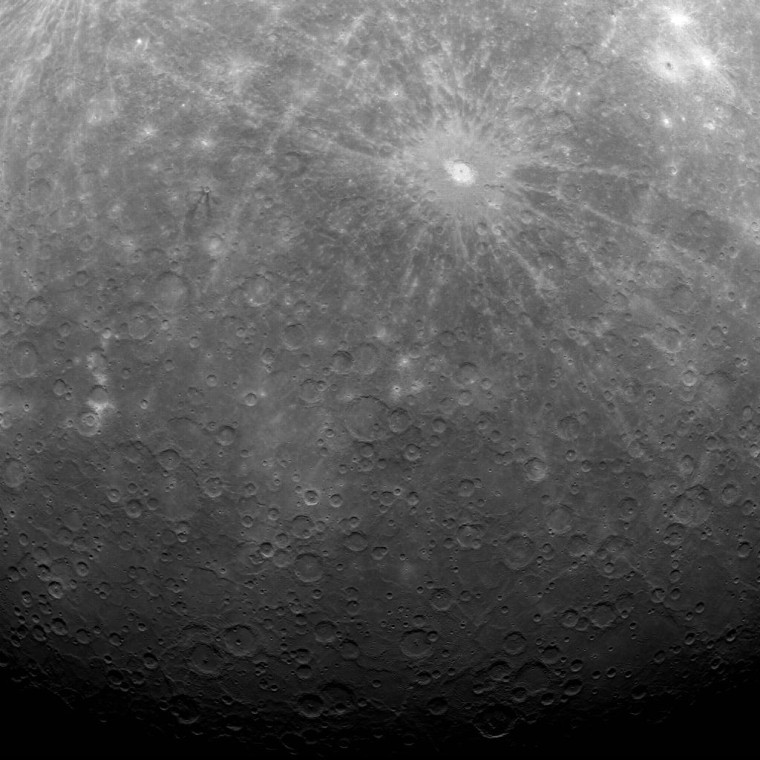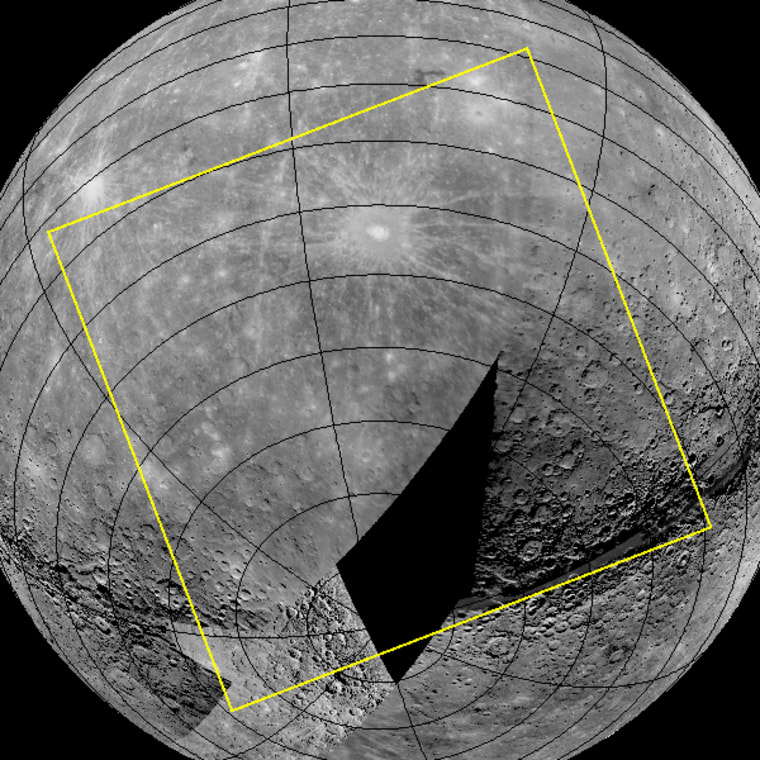
Last updated 3:40 p.m. ET March 30:
NASA's Messenger mission unveiled the first picture of the planet Mercury taken by an orbiting spacecraft on Tuesday, and promised to provide more goodies in the days and months to come.
The picture shows a wide region of Mercury's southern hemisphere, including the south pole and a wedge of the planet that has never been photographed close-up before. But you'd probably be forgiven if you wondered whether the Messenger probe was orbiting the moon rather than Mercury: The monochromatic, heavily cratered terrain looks a lot like the lunar surface.
Here's a description of the scene from Messenger's science team:
"The dominant rayed crater in the upper portion of the image is Debussy. The smaller crater Matabei with its unusual dark rays is visible to the west of Debussy. The bottom portion of this image is near Mercury's south pole and includes a region of Mercury's surface not previously seen by spacecraft. Compare this image to the planned image footprint [displayed below] to see the region of newly imaged terrain, south of Debussy."

Messenger's science team is already familiar with most of Mercury's terrain. The $446 million mission got under way in 2004, and the desk-sized probe zoomed past Mercury in 2008 (twice!) and in 2009. At its closest, Messenger came within 124 miles (200 kilometers) of the surface, which is much closer than the distance from which today's picture was taken (about 9,500 miles or 15,000 kilometers).
But Messenger (whose name comes from the acronym for MErcury Surface, Space ENvironment, GEochemistry and Ranging) wasn't in orbit back then. It was just passing through. The probe finally entered orbit around Mercury on March 17 and is now going through its commissioning phase.
The Messenger mission's principal investigator, Sean Solomon of the Carnegie Institution of Washington, said in a news release that he and his colleagues were "thrilled that the spacecraft and instrument checkout has been proceeding according to plan":
"The first images from orbit and the first measurements from Messenger's other payload instruments are only the opening trickle of the flood of new information that we can expect over the coming year. The orbital exploration of the solar system’s innermost planet has begun."
Today's picture, snapped at 5:20 a.m. ET, was the first of 364 images that were acquired during a span of six hours and sent back to Earth, Messenger's mission team said. More than 1,000 images are due to be taken during the probe's checkout. During Messenger's yearlong science campaign, more than 75,000 pictures are to be sent back.
Mercury has been studied during flybys before, most notably by Mariner 10 in 1974-75, but Messenger is the first spacecraft to orbit the solar system's innermost planet. It's also the densest planet, as well as the planet with the largest daily variations in surface temperature.
Just how big is Mercury's metal-rich core? Do deep, permanently shadowed craters at the planet's poles contain ice? What does its atmosphere (or "exosphere") contain? Why does Mercury have a global magnetic field, while Venus and Mars do not? Messenger's team plans to address all those questions in the year ahead. Some of them may even be addressed on Wednesday, when team leaders are due to discuss Messenger's first images at 2 p.m. ET during a NASA teleconference. Stay tuned for updates after the scientists have had their say.
Update for 3:40 p.m. March 30: Still more pictures were released on Wednesday, as promised. Check out this Photoblog gallery featuring three of the best images, and check back later for still more about the successful start of Messenger's orbital mission.
More about Mercury:
- 10 surprising facts about Messenger
- Is Mercury an incredible shrinking planet?
- Mercury just might hit us someday
- Interactive: The new solar system
Join the Cosmic Log community by clicking the "like" button on our Facebook page or by following msnbc.com science editor Alan Boyle as b0yle on Twitter. To learn more about my book on Pluto and the search for planets, check out the website for "The Case for Pluto." And if you want to stay on my good side, don't ever call Mercury the "smallest planet."
